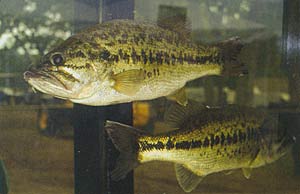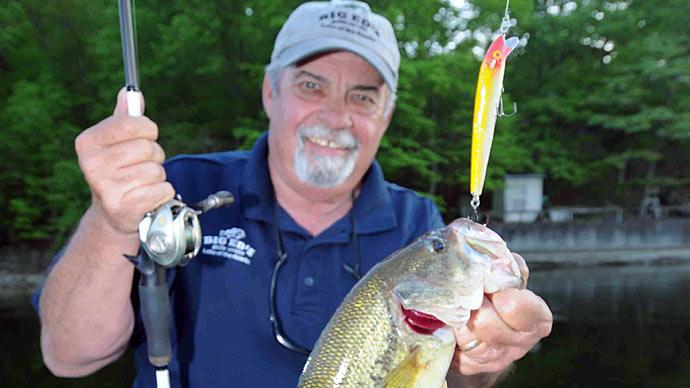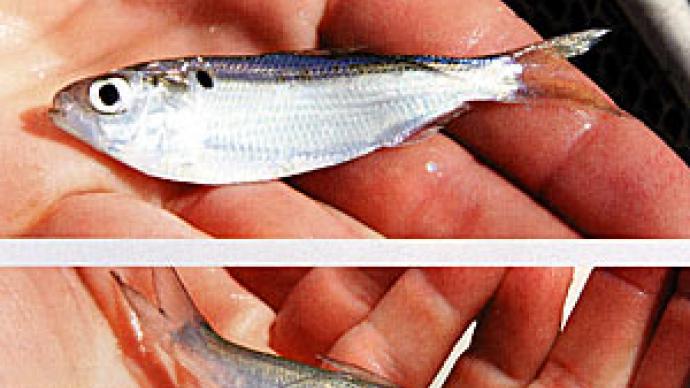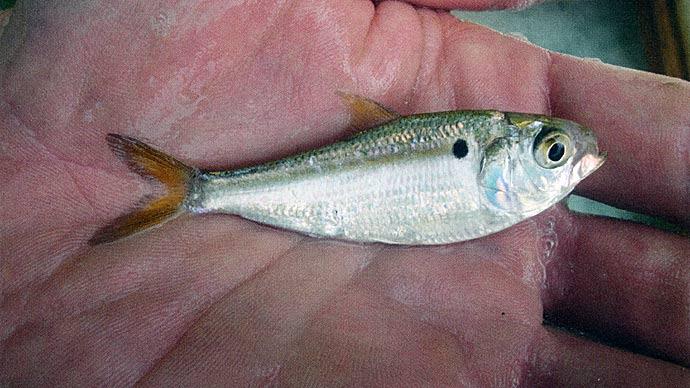
Long time Pond Boss subscriber Dick Faurot. from Tulsa. Oklahoma is a provocative, thoughtful man. For years, he has been emailing thoughtful questions about his pond environment. His latest round was a fairly "simple" question about carrying capacity and the food chain. He wanted to know how fish are distributed by size and number, and ultimately how his bass are affected." ... you stated a well managed pond carries no more than 100 pounds of fish per acre. That answer really surprised me as you have also stated that in the same type of pond, one can expect about 50 pounds of bass per acre. These numbers seem at odds, especially since bass convert their food at about 10 to 1."
His rationale is that the food chain is a pyramid, with the largest volume of food at the bottom in the form of plankton, then insects, into small fish which feed the larger fish, on up to medium size fish, then into the biggest creatures. Since that's the case, my numbers don't jive.
He's right.
Here's the way the food chain works in a bass pond. The same principles apply to all fisheries, but a largemouth bass pond has its own intricacies which make it unique. And, as another qualifier, bass ponds in the north are a wee bit different than those in the south. But, not because of bass so much as because of what they eat.
Most discussions about the food chain begin at the bottom. Today, we start at the top. Look at largemouth bass. In their environment, largemouth bass are the dominant fish. They have a bigger mouth than anyone in the pond, aggressive habits and the ability to successfully reproduce better than other fish, every year. They win. By winning, they can lose, too. Like a Sumo wrestler, they overeat. With bass, however, the green sided creatures run out of food while the wrestler drives to another smorgasbord.
An outstanding, well managed pond can produce and sustain 75-80 pounds of largemouth bass per acre. It takes work to do it, but it can be done. Think about that for a minute. An acre is an area about the same size as a football field. Inside that field, tucked away near some kind of structure or cover, at whatever third dimension depth they choose, that crop of bass sits, doing what bass do. 75-80 pounds of bass may be 40 fish ... it could be several hundred, depending on their average weights and size distribution. Visualize that.
Here's what it took to get those 75-80 pounds of bass. It took 750-800 pounds of living food, captured, swallowed and digested. Here's where the numbers seem to conflict. If a pond were static, we could assume there to always be ten times the amount of forage fish than bass. But, since a pond is dynamic, always changing, the converse statement is actually true. There can't be ten times as many forage fish as bass, ever. (Except the first day baby bass are stocked into a properly stocked new pond loaded with forage fish) Bass see to it that forage fish numbers are consistently on the decline. This is where it gets confusing because of these darned fisheries terms ... "standing crop, carrying capacity and productivity." While these are all interrelated, they are totally different concepts, especially when trying to figure out what this food chain thing is. Keep the word "dynamic" at the front of your mind as you analyze your fishery.
"Dynamic" is also the reason bluegill are the backbone of the food chain for largemouth bass. Bluegill are the only fish which can reproduce fast enough to keep pace with bucketmouth bass without being rendered extinct. In the south, bluegill can, and will, spawn three to four times. Some areas of the nation see bluegill spawn as many as five times. Depending on the pond, bluegill disappear faster than fried chicken at a Baptist picnic. (I'm a Baptist, by the way.)
Since the pond has 75-80 pounds of bass, it HAD to produce 750-800 pounds of baitfish. It did. It just didn't do it all at once. It did it over a long period of time, like a garden. At end of the year, your garden may have produced five bushels of tomatoes, but it did it ten or twenty tomatoes at a time. When it comes to forage fish, your pond produces the same way. There are peaks and valleys, highs and lows. In the spring, expect to see lots of baby fish. By midsummer, expect that crop to be gone, down the gullet of waiting bass. By late summer, there you go again ... more babies, gone again. That is one of the main reasons fisheries biologists suggest another species of forage fish, such as threadfin shad to supplement bluegill stocks ... to minimize and spread out those valleys.
That leads to the next level downward of the food chain. Without tiny morsels of food, tiny baby fish can't thrive. That level is small insects and plankton. Tiny fish, when they are first hatched, have no body fat. And with a mouth about half as big as the head of a pin, they are limited as to what they can eat. In order to grow 750-800 pounds of baby fish to grow 75-80 pounds of bass, you need 1.500-2.000 pounds of plankton and tiny bugs. Those microscopic plants and tiny insects have to be swimming in the water and available WHEN those baby fish need them.
That's why some biologists suggest fertilizing ponds during spring and early summer months. That's because a nudge of nutrients feeds the plankton, which feeds the insects, which feeds... you know the story. But, since the pond NEVER has 750-800 pounds of baitfish at the same time, it NEVER needs 1,500 pounds of microscopic creatures at the same time. It needs them when it needs them, to be consumed when something consumes them, during and after the spawn.
That's why biologists tell you the most important concept in fish production is "timing, timing, timing." It also helps to understand why a "normal" pond, on any given day, has a standing crop of 100 pounds of fish, give or take. Standing crop, from a food chain point of view, is the amount of fish a pond has in it at any given moment. Here's a side note: some biologists look at standing crop as EVERY living thing, including amphibians, bugs and plants. Since we are talking about the food chain for bass, standing crop is fish. See it this way...if we drained the pond, weighed and counted the fish, how much would we have? That's the standing crop.
That leads us to "carrying capacity." From a food chain standpoint, carrying capacity is the maximum amount of living "stuff" a pond can have in it without completely distressing the system. Carrying capacity is also dynamic. A pond can't sustain as many fish in August hot, fertile water as it can during cooler spring months. That makes "carrying capacity" more of a water issue than a living thing issue. Peak productivity periods could push the carrying capacity of a pond, but since bass overeat, carrying capacity doesn't have much of a chance to be pushed to its limits with fish.
Early in my career, I spent time learning how to raise catfish, to feed the masses of a local market. I kept reading about these Mississippi fish farm ponds which produced 10.000 pounds of catfish per acre. I was struggling to ever have more than 2,500 pounds of the skinned creatures at any one time without doing some major water management. Without quite understanding what was going on, it seemed that 2,500 pounds was carrying capacity. More fish than that led to serious water quality issues. After a few phone calls and several visits to these major fish farms, I quickly saw how these folks were doing what they were doing. It was a labor intensive system of "cropping" the bigger fish, which meant they were harvesting often. Plus, energy costs were high because each pond was heavily aerated. Good management strategy for them, not good for me. They were artificially propping up the productivity with heavy feeding, heavy aeration, water exchange and dragging a seine through the pond every month to snatch those fish which dared grow fast.
Excuse me. I think we were talking about the bass food chain.
I have been involved in draining and renovating a number of unmanaged ponds over 27 years of this pond management stuff. In early years, I let landowners convince me (since I didn't know) to trudge around in the bottom mud, up to our thighs in smelly silt, dragging a seine, to catch all the fish we could catch. Pond in, pond out, year in, year out, there were never as many fish as any of us thought. In a half acre pond, we might retrieve 200 adult bluegill, 1.000 baby bluegill and 30 bass that weighed half a pound to the three which weighed two pounds. All told, that mess of fish might fill up two five gallon buckets.
Standing crop in a bass pond can be increased by your management strategy. That's why people use feeders and fish food. Feeding floating fish food to fish increases the standing crop of the food chain, which increases the standing crop of bass.
And, that standing crop of bass is what confuses people.
Since bass sit at the top of the food chain of bass lakes, they are about the only thing which remains fairly constant. The dynamics of bass are not quite as dramatic as the dynamics of what they eat. Since a superbly managed pond might have a standing crop of 75-80 pounds of bass, don't assume there to be ten times that many baitfish.
That's why biologists teach us to take care of our adult bluegills. Those are our brood fish. We need those big bluegill to be cared for, so they can have lots of babies during the course of the year to provide a cafeteria load of baitfish for those bass lying in wait.
So there you have it. The food chain for bass. Oh, gotta run. I hear the princess calling. It's time to eat that next pound of food she has so graciously prepared. Since I will probably eat 600 pounds of food this year to maintain my portly relative weight of 180lbs, I best follow her orders, even though the refrigerator never seems to have more than half a serving of soup and some leftover lettuce.
Veteran fisheries biologist Bob Lusk runs Texoma Hatchery pond consulting service. He may be reached at 903-564-5372. His new book, "Raising Trophy Bass," may be purchased by calling 800-687-6075.
Reprinted with permission from Pond Boss Magazine



